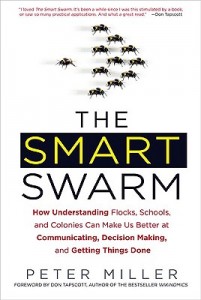Smart Swarm: Birds, Bees and Better Business
What can bugs, birds and fish teach us about the way we do business?
The constraints of the organizational hierarchy common in today’s economic landscape are incompatible with the emergent norms and values of the modern market. What’s needed is a more adaptive system which appreciates the flexibility and responsiveness of individuals working dynamically together to realize goals. What we need is a smart swarm.
In Smart Swarm (How Understanding Flocks, Schools and Colonies Can Make Us Better at Communicating, Decision Making and Getting Things Done), author Peter Miller asks and explores how the complex adaptive systems of other life forms have evolved to generate effective, organic collective behaviors. He praises their wisdom and hints that we, as humans, can take cues from their models.
Miller defines a smart swarm as ‘a group of individuals who respond to one another and to their environment in ways that give them power, as a group, to cope with uncertainty, complexity, and change’. What we as humans have forgone is the understanding of this interwoven and connected type of system – this smart system – as an optimal driver for productive behavior. In its stead, we have convinced ourselves that the hierarchy – with its command, control and predictability – is the model upon which productivity must be built.
Miller illustrates, via voyages through ant colonies, termite hills and schools of fish, that the smartest system of all is not the hierarchy of top-down control. It’s the complex adaptive system where less is more – wherein one must paradoxically forgo control for the externalities of connectedness, adaptability, responsiveness and flow that arise from the bottom-up systems that fuel evolution.
The smart swarm operates through four principles: indirect collaboration, adaptive mimicking, self organization and diversity of knowledge. Miller shows how species are able to navigate their social environments to create successful complex adaptive systems with the principles of a smart swarm at work.
For illustration’s sake, let’s consider the diversity of knowledge, which says that greater sources of information lead to strengthen the collective judgment. The key here is to minimize the influence of outside factors which could taint each input. At work, this means reducing irrational collective behavior by removing polarizing stimuli like power and titles inherent in today’s organizational hierarchies.
Miller argues that the reason we are so susceptible to these external influences is because we have ‘caveman brains’. Biases hinder our ability to make accurate individual judgments because our individual brains haven’t evolved to deal with decisions in complex situations on their own. However, as a growing list of scientists and researchers believe, our collective brain is more than able.
As Miller illustrates, bees seemed to have mastered this collectively genius approach to problem solving. Scout bees use waggle dances to help hives determine their future nesting spots. Many scouts perform dances in favor of many different nesting locations, but the intensity and duration of the dances act to influence and persuade others to move. No title or rank at play, just diverse scouts free to justify their opinions for the collective good.
This illustration also highlights the dark side of smart swarms with a word of caution as we shift our systems from top-down to bottom-up. For the principle of diversity of knowledge, subtle influences, like power and rank, can introduce biases into these so called ‘smart’ systems, rendering them counterproductive. Illustrated further, Miller uses the principle of adaptive mimicking in the context of locust swarms to illustrate how subtle changes in the environment can sway the collective behavior to its detriment. For locust swarms, a change in temperature can alter the way each individual insect perceives local information, leading to aggressive collective behavior that endangers the swarm’s long term survival (crops are quickly devoured, depleting a food source necessary for the locusts and other co-inhabitants of the environment).
Cautions aside, Miller’s analysis and interpretation of nature’s organic adaptive systems hints at the type of evolution organizational leaders should be striving to understand as we move into the next great economic paradigm. Authors Don Tapscott and Anthony Williams, in Wikinomics, describe this economic shift as having the qualities of openness, transparency and collaboration. With these values, the need to tap the wisdom of crowds in the context of our organizations is becoming increasingly important in the race to create value and stay afloat in the hyper-competitive landscape.
Thus, Miller’s exploration of nature’s complex adaptive systems becomes paramount to understand as we enter new social and economic frontiers. Though we have an advanced cognitive set, we can take at least some of our cues from our planet’s co-inhabitants as we strive to keep up with this increasing complexity.
In our economic environment, the hierarchal organization, with its rigid communication channels and sluggish response, is ill equipped to handle feats of accelerating adaptability and change. The flatter, organic organizations, much like the smart swarms of nature, are better prepared to step up to the challenges of the modern, wired economy.
Natural systems have evolved to interconnect and create super-organisms. Using the same guiding principles, we can evolve the economic institutions we devote our lives to from being mere organizations to super-organizations.
(PeopleTalk Fall 2011)









